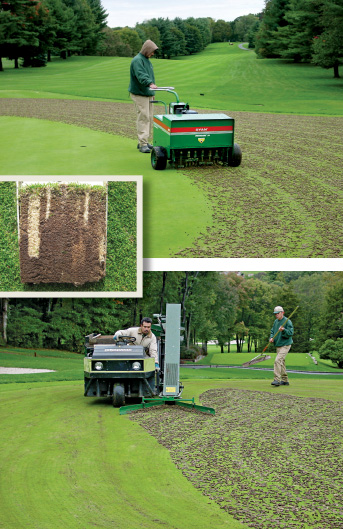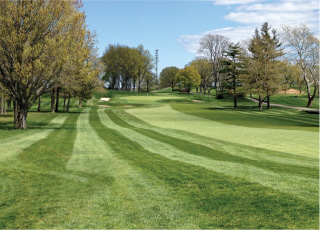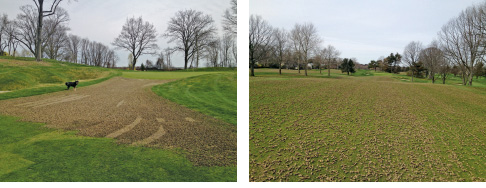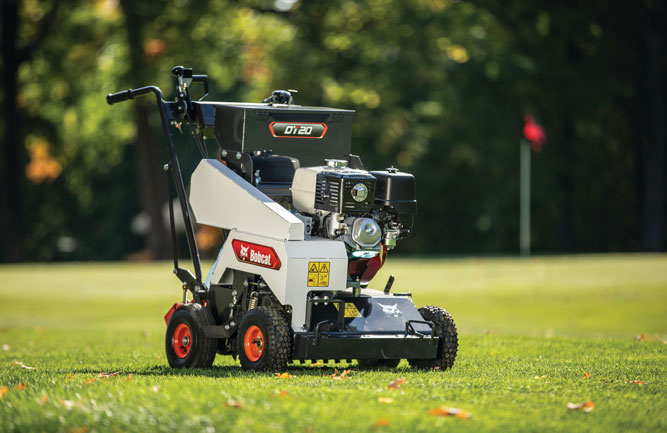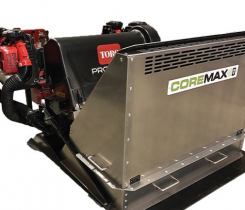Plant Health Series: Part 1
How about this weather? Many parts of the country saw snow in May. Snow in May? Mother Nature’s sense of humor seems to get more peculiar by the year.
Now summer stares us down. The golfers will shake off this cool spring and courses will get busy. The life cycle of golf, just like the life cycle of turf, continues.
Golfdom, in partnership with BASF Professional Turf and Ornamentals, is proud to once again bring readers the Plant Health Series. In part one we look at the art of aeration. In part two, we’ll take a look at beating the heat, which is sure to come.
Here’s to healthy plants in 2013.
Separate the pretenders from the contenders
By Rich Kalik
These days lots of basic manufacturers are making plant health claims in our marketplace. But let’s look back and see if we can separate the pretenders from the contenders.
Back in 2010, when BASF launched its Intrinsic brand fungicides to the marketplace, we had facts and data to back it up. First, and foremost, we had it on the label. EPA registered fungicides for disease control and plant health. That’s a tall standard to equal right there, but in addition to that we published more than 20 pages of research on the plant health benefits Insignia SC and Honor Intrinsic brand fungicides provided both warm and cool season turf.
It’s three years later and our portfolio has grown to include Pillar G Intrinsic brand fungicide in turf and Pageant and Empress Intrinsic brand fungicides for use in production and landscape ornamentals.
And the published research by BASF on how these products perform, of the benefits they provide, has grown to more than 70 pages. By the way, you can see for yourself by visiting www.intrinsicplanthealth.com. We have golf course superintendents just like you who have added Intrinsic brand fungicides into their spray programs and managed stress events including drought, temperature extremes and aerification. They’ve seen the benefits firsthand.
It’s important to note that the common denominator in all these products is the active ingredient pyraclostrobin. This is proprietary chemistry from BASF. On the crop side of our business, products with pyraclostrobin don’t just provide disease control, but also increases yields. This is proven and published research and real world results. There is something physiological that occurs to the plant, be it corn, soybeans, turfgrass or petunias that enables it to manage stress and stay healthy.
So it’s three years later and we see from the others who claim these benefits lots of slick marketing pieces with me-too language, but just how much research have we seen that backs it up?
Exactly, and those guys are the pretenders.
The reliable standby of facts, data and research is still the measuring tool you should use when it comes to deciding what to use for taking care of your golf course turf.
Next month, we’ll be sharing a secret to keep your turf healthy this summer. Here’s a hint, it begins with including Honor Intrinsic brand fungicide in your spray program for Memorial Day weekend.
In addition, we’re talking a bit about the next round of disease control and plant health innovations from BASF that will arrive later this year.
Until then, keep your turf healthy my friends.
Rich Kalik is Technical Specialist, BASF Professional Turf & Ornamentals
Let the air in
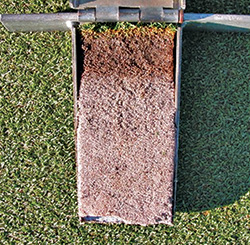
The darker brown area in the top 1 to 1.5 inches of the profile is the area where excessivie organic matter can accumulate and hinder gas (especially oxygen) exchange between the atmosphere and soil environments. To maintain ample gas exchange, this zone must have sufficient macropores (pore with diameters >0.075 mm). Macropores also are the means for rapid infiltration of excess water into the soil during rains. Photo: Rich Kalik
For superintendents on golf courses far and wide, aerating is a necessary evil — a superintendent’s ticket to healthy root systems. Without it, the lifespan of turf would be much shorter, roots would be dying and there would be far fewer golf courses around to play.
How superintendents get the most from their aeration techniques depends on the superintendent’s methods and a golf course’s location. But there’s no denying that, universally, aeration is among the most important contributors to healthy turf.
“I compare aerifying to paying your taxes,” says Garret Bodington, superintendent at Sebonack Golf Club in Southampton, N.Y., which is hosting the U.S. Women’s Open in June. “If you don’t pay your taxes you’re going to get in trouble, and if you don’t aerify you’re going to get in trouble.”
Bodington asserts that plant health products work in conjunction with aerifying to create better results. “You get quicker results when you put down fungicides and fertility products before you aerify,” he says. “With the Intrinsic line, which I use, if you put it out before you aerify, they say your healing time will be shorter due to the fact that it strengthens your roots and leads to development of healthier roots in the long term, and that’s what I’ve found.”
Bodington has applied fungicides pre-aerification for a while now, but he really started seeing marked improvement from it in the last three years. “It really stems back to root development and to how quickly the roots bounce back,” he says. “You see longer and thicker roots. It’s noticeable.”
During times of stress, such as in mid-July and early August, Bodington has found that even then “our roots have continued to flourish and do well.”
Though Bodington applies plant health products before aerification, they can work just as well when applied post-aerification, he says.
No matter if plant health-labeled fungicides and fertilizers are applied pre- or post-aerification, Bodington says there’s no denying aerifying itself is crucial.
“Aerification is vital to plant health,” says Bodington, who has bunkers in the middle of his fairways, making aeration a challenge. “If you don’t remove the plug or create a hole, you’re stopping the ability of new plants to grow into that open spot.”
Benefits
Aerating is important because it removes thatch, opens up the surface and lets oxygen flow to the root system. It also allows for water movement, says Bob Carrow, a professor in the Crop and Soil Sciences Department at the University of Georgia. To be healthy, root cells require oxygen, otherwise they die back, he explains.
“If the root cells can’t breathe, it’s got to come by diffusion to reach the root cells,” he says. “That’s problematic if you get surface conditions where it starts to seal up the surface.”
That sealing leads to a buildup of organic material on the turf’s surface, and the turf won’t dry during wet periods, he says. “Essentially you’ll get so much moisture that it hinders air movement. You have to have larger pores going across that zone to have good air movement.”
When Pat Gross of the USGA does site visits, he makes a point of showing committee members and non-superintendents where the healthy roots are growing. “They’re growing where the air is,” he says. “They need a balance of air and moisture to grow healthy roots. The main reasons for core aeration is, soils get compacted over time. Core aeration releases soil compaction and improves water infiltration into the soil,” thereby creating a better avenue to the root system.
Effective aeration techniques are subjective, varying from course to course, says Tom Kaplun, superintendent at North Hempstead Country Club in Port Washington, N.Y. But “the one thing that’s not subjective is that you’re trying to promote gas exchange in the soil and encourage deeper rooting,” he says.
This spring, Kaplun vertiquaked his course before he aerified to create that deeper rooting and better drainage with much success.
Aerating is futile without topdressing in conjunction with it, Carrow says. Bodington agrees, saying superintendents can achieve optimum results by supplementing a balanced fertility program with a sound topdressing program. “That’s when you see the best results,” he says.
If you don’t add sand after a core aeration and “create conditions where you have good microbial decomposition of the organic matter,” Carrow warns, “it’s very easy to get more organic matter buildup.”
The true test
Tony Girardi, superintendent at Rockrimmon Country Club in Stamford, Conn., knows all about organic matter buildup. And he feels so strongly about the importance of aeration that when he talks about it you can hear the passion in his voice.
“I am passionate about it, because I feel strongly that it’s the best way to help with greens management,” he says. “Organic matter displacement is critical to the overall health of green putting surfaces.”
Girardi got a strong reminder of that in 2007. His greens were failing because organic matter in them was accumulating. “No water could get in,” he says. “The turf was suffocating itself.”
And it couldn’t have come at a worse time. It was the high season, and rounds were booming. The golf course was busy “24/7,” never leaving time for Girardi to perform agronomic practices, he says.
Girardi and his team had no choice but to reassess their techniques. “We had to press the ‘restart’ button and rethink how we were prioritizing our agronomic practices on the course,” he says.
Girardi decided to send his soil samples away to a soil lab in Missouri to have them tested. He’s glad he did; the test results not only gave him solid data on the soil’s water-holding capacity and enabled him to devise a strong aerification program, but it also empowered Girardi in dealing with his green committee and membership.
“Aerifying disrupts play,” he says. “Having the samples tested gives me solid scientific data that I can report to my green committee and say, ‘This is why I need to aerify this many times a year.’ You can’t dispute it. You can say, ‘This is what a scientific laboratory is saying.’ Once I had all this scientific data, it demonstrated that we have a major issue and it’s not something that’s going to turn around overnight.”
After he got the test results back, Girardi started aerifying aggressively, tapering off just this year. Now he aerifies once in the spring and fall and supplements those with two hydroject aerifcations a year.
Thanks to his ramped up efforts, as time has gone on Girardi has seen a decrease in organic matter and been able to aerify less invasively.
Thanks to aeration’s cumulative effect, within the last two years he has seen measurable improvements, especially in the soil’s water holding capacity and porosity.
“For us, the testing allowed us to identify exactly what we had to do,” he says.
All in the timing
It was late April, and the crew at North Hempstead Country Club had just finished aerating. One week later, superintendent Kaplun arrived at work to see huge divots in one of his fairways.
“I was a little upset when I saw that, because when you do aeration, you send communication out to members and let them know how long the recovery process will be, you let them know to be extra cautious,” he says. “You get some golfers who obviously come out to use the golf course as a practice facility. They want to practice a certain shot. I understand that, and typically I don’t have a problem with it.”
In the spring, aeration at North Hempstead Country Club is done over three days and is an intensive process, Kaplun says. Kaplun aerates his fairways, tee boxes, greens, and this year even his roughs. He also aerates his greens in the fall and late summer.
It’s not enough to just aerate in the spring or fall, Kaplun says. Both spring and fall aerations are “a necessary evil” to protect the turf from summer stress, says Kaplun, who stresses the importance of efficiency and timeliness in doing aerations, to both ensure plant health and allow the return of play quickly.
Gross says normal turf recovery after an aeration is 14 days. But he often sees superintendents make mistakes in the timing of their aerations, which leads to slower turf recovery.
“You want to aerate at a time of year when (turf) will recover the quickest,” he says. “Doing it when it’s convenient is a recipe for failure.”
As silly as it sounds, Gross says, when aerating, superintendents need to think like plants. “You have to aerate at a time when plants are ripe for growth and development,” he says. “It takes longer for the greens to heal when you don’t aerate at the optimum time.” Length of recovery also depends on the size of the hole, he says.
Gross adds that superintendents have done a less than stellar job of aerating greens in recent years. The reason for that isn’t their technique so much as the quality of the equipment superintendents are using, he says. “You want a clean surgical cut,” he explains. “That way, there’s less impact for the golfers.”
Even given all of this, says Kaplun, there’s one thing about aeration that will likely never change. “Aerating is one of the most important aspects to plant health,” he asserts. “You can spray as many chemicals and fertilizers as you want, but if your turf’s not healthy, it’s not going to matter.”







